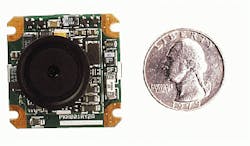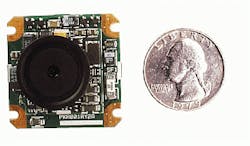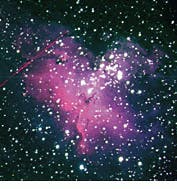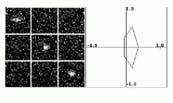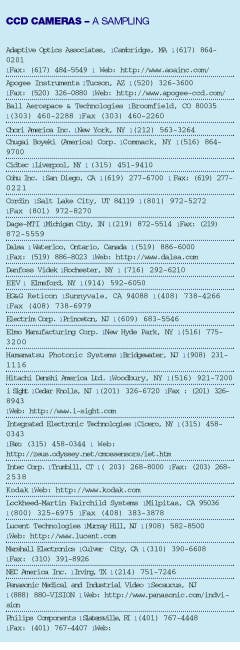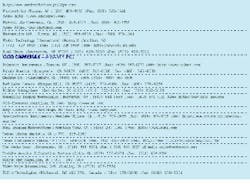VENDORS TAILOR ccd cameras TO SPECIFIC APPLICATIONS
VENDORS TAILOR ccd cameras TO SPECIFIC APPLICATIONS
By Rick Nelson, Contributing Editor
Invented by Bell Laboratories in 1969 as solid-state computer memory components, charge-coupled devices (CCDs) proved noncompetitive in cost and performance with dynamic random-access memory (DRAM) technology. But Bell Labs put the devices to work in solid-state cameras in 1970, and, by 1975, the devices were achieving broadcast-level performance. Today, CCDs are used in a range of applications from consumer products to astronomy.
Whereas low-cost, high-volume CCDs provide scan rates and resolutions of television format, more-expensive, higher-resolution devices afford photon-level sensitivities and fast frame rates. But even as such high-performance CCDs seek to oust film, CCDs themselves are facing competition from CMOS active-pixel sensors that integrate image acquisition with associated control electronics.
Nevertheless, CCDs have a long future in scientific applications. In such applications, digitizing images for personal computer (PC) processing is the focus of many camera vendors. For example, the ISC2020 camPuter board-level NTSC or PAL camera from i Sight Inc.(Cedar Knolls, NJ) provides digital-video control circuits on a single PC/AT board.
Leveraging its consumer-oriented camcorder technology into industrial and medical markets, Panasonic Medical and Industrial Video (Secaucus, NJ) is offering the GP-MF802, a progressive-scan machine-vision camera that acquires full-frame still images of moving objects in 1/60 s and the GP-CX141 color board camera that measures 32 ¥ 32 ¥ 23.5 mm and delivers a resolution of 330 lines (see Fig. 1).
Heavenly observations
In addition, CCD cameras find considerable use in astronomy. For instance, they are used in the Hubble Space Telescope, NASA`s Galileo mission, and the European Space Agency Giotto mission`s fly-through of Haley`s Comet. All three applications use charge-coupled devices from Texas Instruments (TI; Dallas, TX); these CCDs use a virtual phase technology to achieve 70% quantum efficiencies. To further simplify system design, TI offers clock drivers, timing generators, sample/hold circuits, and video processors.
On the Big Throughput Camera (BTC), Bell Labs` researchers collaborated on a mosaic of four large CCDs that has quadrupled the efficiency and coverage of the 4-m Blanco telescope at Cerro Tololo Interamerican Observatory in Chile (see Fig. 2).
NASA`s Jet Propulsion Laboratory (JPL; Pasadena, CA) also has been a pioneer in CCD astronomy applications. Its Near-Earth Asteroid Tracking (NEAT) camera uses a 4096 ¥ 4096-pixel CCD installed on a 39-in. telescope operated at the summit of Mt. Haleakala (Maui, HI) by the US Air Force. The camera and the associated software enable the identification of faint moving objects by the automated comparison of successive images (see Fig. 3).
But CCDs for astronomy applications are not limited to professionals. To attract amateur astronomers, a range of camera products from Apogee Instruments (Tucson, AZ) include the AM4, the AM16, and the AM13. Featuring Kodak sensors, all three cameras provide 768 ¥ 512, 1536 ¥ 1024, and 1280 ¥ 1024 resolutions, respectively. What`s more, the three cameras utilize controller interfaces that deliver images to PCs in 6-24 s. They contain a lightweight camera head, PC controller board, 10-ft cable, and image-processing software.
Apogee Instruments also offers other imaging systems, ranging from the AP1 that uses a 768 ¥ 512 CCD from Eastman Kodak Co. (Rochester, NY), to the AP10 that uses a 2048 ¥ 2048 CCD from SGS-Thomson (Carrollton, TX), to a CCD system that furnishes an 85% quantum efficiency from Scientific Imaging Technologies (Beaverton, OR). All the cameras products include ISA bus PC controller interfaces.
Low-light, scientific astronomy applications require low-noise, cooled CCDs. Photometrics (Tucson, AZ) supplies a camera dubbed the Quantix that delivers low read noise at readout rates of 5 Mpixels/s. Because the Quantix camera is forced-air or liquid cooled, it is suitable for long exposures in low-light applications. A PCI interface provides input to a PC or Macintosh.
Also offering cooled imaging systems, SpectraSource Instruments (Westlake Village, CA) incorporates 10-, 12-, and 16-bit analog-to-digital (A/D) resolution and up to 3k ¥ 2k-pixel CCDs. These systems aim at applications requiring high sensitivity and good signal-to-noise (S/N) ratio in near-infrared, visible, and near-ultraviolet applications. SpectraSource cameras use CCDs from EEV (Elmsford, NY), Eastman Kodak, Scientific Imaging Technologies (Beaverton, OR), and Texas Instruments.
Speed and sensitivity
Focusing on fast framing, the MD4256C 256 ¥ 256 ¥ 8-pixel 1000-frame/s CCD camera from Adaptive Optics Associates (Cambridge, MA), when combined with its SB4001 companion PC/AT compatible frame buffer, forms a complete fast-framing video system costing less than $20,000. The firm`s KV1256P system combines camera, frame buffer, and personal computer in a portable, battery-operated package suitable for harsh environments.
Taking aim at sensitivity and speed, the time-delay-and-integration (TDI) cameras from Dalsa (Waterloo, Ontario, Canada) deliver 80 times the sensitivity of conventional linescan equivalents, according to the company. Demonstrating that resolution and sensitivity need not burden speed, the company`s D4 camera provides a resolution of 1024 ¥ 1024 pixels at speeds to 40 frames/s.
Princeton Instruments (Trenton, NJ) offers intensified charge-coupled-device (ICCD) cameras for applications demanding single-photon sensitivity. Intensified cameras use a photomultiplier positioned in front of the CCD to boost sensitivity. The company also offers fiber-coupled slow-scan ICCDs and video-rate versions. Photon Technology International (Monmouth Junction, NJ) also offers intensified CCD cameras. Its IC-110, IC-200, and IC-300 ICCDs provide sensitivities ranging from 200 to 800 mA/lm include a frame grabber and software.
Challenging CCDs
Drawbacks of charge-coupled-device sensors and cameras include the high cost of scientific-grade devices (prices climb to $25,000 for a perfect 1k ¥ 1k-pixel device) and the need for bulky and power-consuming support electronics. Because of these shortcomings, the JPL is turning to active-pixel sensors (APSs); the laboratory has already developed a CMOS active-pixel sensor that uses active CMOS circuits along with each pixel`s photosensor. The technology has been licensed by Photobit (La Crescenta, CA); the firm plans to introduce a color imaging array with digital output and complete on-chip image-command, control, auto-exposure, and shuttering. Photobit expects APS power consumption to be 100 times less than equivalent CCDs.
Other companies working with CMOS-based imagers include Suni Imaging Microsystems (Mountain View, CA) and Integrated Electronic Technologies (IET; Cicero, NY). Suni has developed a proprietary 5-V CMOS-CCD process technology that enables the integration of an entire digital camera on a single chip. IET has developed a number of random-access and sequential charge-injection-device CMOS imagers, including ones that incorporate very-low-noise preamplifiers.
FIGURE 1. Delivering 330 lines of resolution and measuring 32 x 32 x 23.5 mm, the CCD camera-on-a-board from Panasonic Medical and Industrial is targeted at OEM applications.
FIGURE 2. Color mosaic of the Lagoon Nebula taken with the Big Throughput Camera spans a wavelength range from 0.36 mm (UV) to 1 mm (near-IR). The zoomed image (right) covers 1% of the area of the full mosaic. Normally, many such exposures are taken, enabling computer reconstruction of a seamless panoramic image. (Photos courtesy Gary Bernstein of the University of Michigan and Tony Tyson and Ian Dell`Antonio of Bell Labs-Lucent Technologies).
FIGURE 3. Automated comparison of successive photos enables the detection of moving objects by the NASA/JPL NEAT camera. Here, an asteroid appears to move from top left to bottom right in mosaic of 25 x 25-pixel segments extracted from 4096 x 4096-pixel raw data. Columns represent three different positions at a given time; rows represent a given position at three different times. The cross-hatch near 1 on the x-axis indicates that the object is moving about 1 per day in an elliptic longitude.
FIGURE 4. Sixty-second-exposure CCD image of Messier 16 was taken with an Apogee AP-7 CCD camera and a 12-in. Mead LX200 telescope. The camera uses a SITe backlit and thinned CCD that achieves about 80% to 85% quantum efficiency in visible wavelength.
